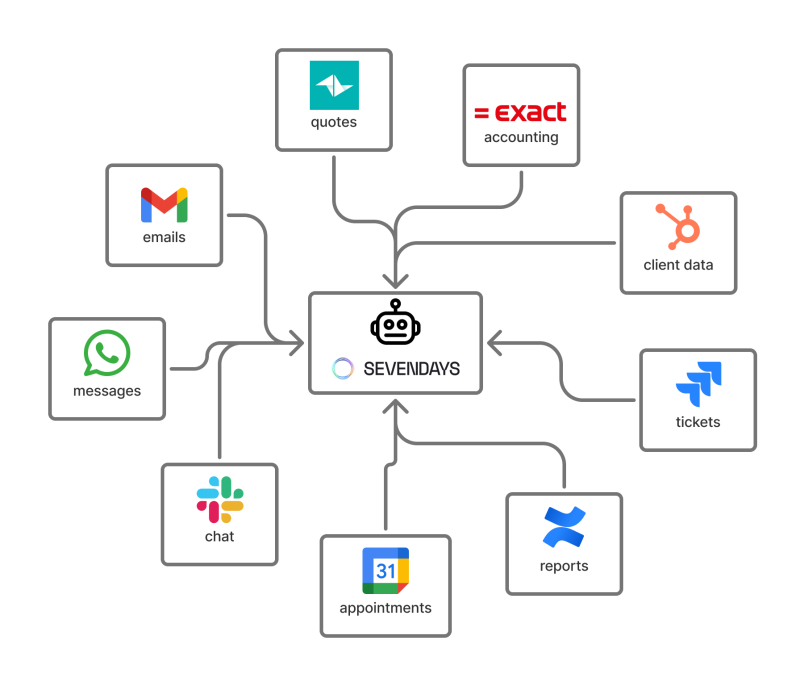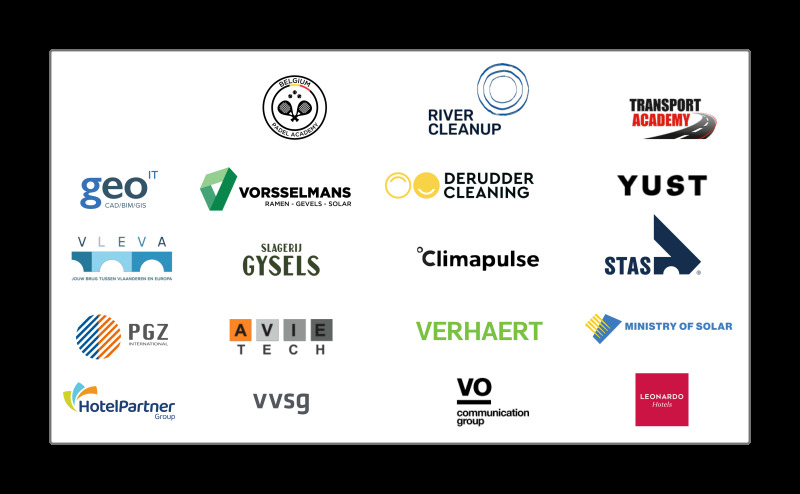Our digital team member: we practice what we preach
We built an AI team member with full company access to practice what we preach about digital transformation.

At Sevendays, we help companies work more efficiently and become more customer-friendly by designing, developing, and implementing digital solutions. But there's one question we constantly ask ourselves: do we actually use the innovations we implement for our clients?
The answer is a resounding yes. And today, we want to take you inside one of our most valuable internal tools: our digital team member.
From theory to practice
It's easy to advise clients about efficiency and automation as a digitalization partner. It's another story to consistently apply those principles in your own organization. Yet that's exactly what we do. Because if we don't believe in the power of the solutions we build, why should our clients?
Our digital team member is the perfect example of this. It's our own version of an internal knowledge system, comparable to ChatGPT but with direct access to all our company information.
What can our digital team member do?
The digital team member has real-time access to:
Client data: all contacts and their information
Commercial information: quotes (approved, ongoing, rejected) including budgets
Project planning: deadlines and milestones of all ongoing projects
Financial data: all outgoing invoices
Communication: meeting and phone call transcripts
Internal chat: complete Slack history
Email traffic: all correspondence with clients
Calendars: appointments and availability of the entire team
Project management: all tickets, tasks and their status
Team structure: who is the point of contact for which project
Time tracking: hours worked per project
Project management without a project manager
We've consciously chosen not to have a dedicated project manager.
Not just for cost savings, but mainly because we believe in a flat organization where knowledge and responsibility are broadly shared.
The digital team member makes this possible by giving everyone access to project information that would traditionally reside with one person.
Democratizing knowledge
Imagine: a client calls or emails with an urgent question about a project, but the lead developer is on vacation.
In traditional teams, this would be problematic. With us, any team member can consult the digital team member, retrieve the complete project history, and help the client expertly.
We don't want crucial information locked away in one person's head. Not during illness, not during busy periods, and certainly not when an employee leaves.
Onboarding new team members
When a new developer joins an existing project, they normally have no idea about decisions made in the past, challenges that were overcome, or the client's specific wishes.
With our digital team member, that new colleague can ask questions like:
"Why did we choose this technical architecture?"
"What are this client's priorities?"
"Have there been previous discussions about this functionality?"
The team member provides answers based on historical meetings, emails, and Slack conversations.
It's as if you have an experienced colleague sitting next to you who has been through the entire project.
Prioritizing based on agreements, not inbox
Email or Whatsapp are great tools, but it too often dictates our workday. An incoming email or Whatsapp message feels urgent, even when it's not always the case.
By querying our digital team member about deadlines and schedules, we can more consciously choose where to invest our energy.
We let our work be guided by agreed priorities, not by when someone happens to send an email.
Context switching becomes easier
Our team leads regularly work on multiple projects per day or per week.
From a Laravel application for client A to a HubSpot integration for client B, and in the afternoon a meeting about a new project for client C.
Those constant context switches are mentally exhausting. Each time you have to re-familiarize yourself: what was the status again? What did we agree on last time? What are the outstanding issues?
With our digital team member, you simply ask the question: "What's the latest status of project X?" And you get a summary based on all relevant sources: tickets, emails, Slack messages, meeting notes.
No more manual searching across different systems.
One source of truth
Previously, "quickly checking the status" meant going through:
Jira for tickets
Slack for informal updates
Email or Whatsapp for client communication
Google Calendar for appointments or team availability
Teamleader for quotes, budget and invoiced amounts
Now we simply ask our assistant.
It automatically combines all sources and provides a coherent overview.
The impact in practice
Since working with the digital team member, we've noticed concrete improvements:
Faster response times: team members can answer client questions without first having to interrupt colleagues
Better continuity: vacation or illness of a team member has less impact on project progress
Higher quality: decisions are made with full knowledge of project history
Less frustration: no more endless searching for "that one email" or "that appointment from last month", the best search tool ever ;-)
More autonomy: junior developers can work more independently because they can always retrieve context
Why this is relevant for our clients
You might be wondering: "Nice for you internally, but what's in it for me?"
First, it demonstrates that we believe in the solutions we propose. We're not consultants selling theories that we never apply ourselves. We live the digital transformation we preach.
Second, we understand the challenges first-hand. We know how difficult it can be to integrate systems, to get team members on board with new ways of working, to prove the ROI of digitalization. Because we've been through it ourselves.
And third: if this kind of efficiency gain is possible for a small team like ours, just imagine what it could mean for your organization.
Phase 1: Retrieving information
What we're currently using is actually the first phase of our digital team member. The focus is on quickly and compactly retrieving relevant information.
You ask a question, the team member searches all sources and gives you a clear answer.
This phase alone delivers enormous time savings. But we're ambitious.
Phase 2: From informing to executing
The next step is to give the digital team member more "rights." Not just providing information, but also executing tasks.
Think of:
Proactive task management
The digital team member can automatically create tickets or tasks based on all available information.
For example: during a meeting it's agreed that "we need to deploy that new feature next week," and the team member automatically creates the relevant tickets with a target date, assigned to the right team member.
Or a team member asks: "Make sure we process client X's feedback in the new version next week" and the digital team member translates that into concrete action items in the system.
Intelligent client communication
When an incomplete client question comes in, the digital team member can automatically send an email to request additional information.
No more waiting time until a team member reads, analyzes and responds to the email.
The digital team member recognizes: "Information is missing to properly assess this" and proactively asks for more details.
This means faster response times and less ping-pong in email traffic.
Personal daily planning
Every morning, each team member receives a personalized briefing:
"Today you need to work on these projects"
"These are your priorities based on deadlines and agreements"
"Note: client Y expects feedback today on their question from yesterday"
No more puzzling with your to-do list yourself.
The digital team member has an 24/7 overview of all projects, deadlines and commitments and compiles a logical workday.
Real-time adjustments
As the day progresses, the team member tracks what you've done and what's still open. Around 4 PM you get a notification:
"Don't forget to deploy that feature today"
"You still need to call clients A and B"
"You won't make this deadline today, should this be communicated?"
It's as if you have a personal assistant thinking along with you all day.
Strategic capacity planning
And then it gets really interesting. The digital team member can provide strategic advice:
"We received a request today from client X to deliver a project of size Y by date Z. Based on our current planning and team capacity, this is possible if we postpone project A by two weeks, or we would need an additional developer from week 12 onwards. Would you like me to work out scenarios?"
This kind of analysis currently takes hours of work: checking all ongoing projects, calculating capacity, weighing alternatives.
The digital team member can do that in seconds, with complete knowledge of all commitments, team capacity, and historical data on how long similar projects took.
Why roll out in phases?
We're building and implementing this step by step, not all at once. Why?
Building trust: The team must first gain confidence in the information the digital team member provides before we give it executive rights
Learning from feedback: We discover in phase 1 what works well and what could be better, and we take those insights into phase 2
Technical complexity: Retrieving information is relatively simple, executing tasks in different systems requires more complex integrations
Risk management: We want to be certain that the digital team member doesn't execute tasks that are incorrect or unwanted
But the direction is clear: from passive information provider to active digital team member.
The future of work
We believe that knowledge work is fundamentally changing. The question is no longer whether you're going to deploy AI and automation, but how quickly and smartly you do it.
Our digital team member is a small but powerful example of this. It's not a replacement for human expertise, but an enhancement of it. It makes our team smarter, faster, and more resilient.
And that's exactly what we want to achieve for our clients too: digital solutions that are not only efficient, but that truly make people and teams better at what they do.
Curious how a digital team member could help your organization?
Or want to know more about how we set this up technically?
Feel free to get in touch. We're happy to share our experiences and think along about what the best approach is for your situation.
Because ultimately, digitalization isn't about technology.
It's about people who can do their work better, more enjoyably, and more meaningfully.
Let’s talk possibilities 🚀
Are you ready to see what digital team member could do for your business? 👉 Schedule a free consultation and let’s explore how we can save you time, cut costs, and give your business a competitive edge.






